
When an Awareness Week Is Not Enough – Engaged Learning Through Learning Campaigns
Using learning campaign portals to create immersive learning campaigns
Some things just can’t be learned in an hour. Or even a week. Things like organisational change management – where attention needs to be focused on a specific topic over a prolonged period. In these cases, sustained learning is key.
It’s a little bit like classic advertising. Coca-Cola’s annual advertising presence, for example, doesn’t hinge on a single one-week TV spot campaign. Instead, the company draws attention to its products over a sustained period using a strong, well-coordinated multi-channel campaign. It’s all carefully designed to ensure consumers reach for the red can the next time they open the chiller.
In the same way, a good learning campaign should bring about a mind shift – ideally one that leads to concrete action. Sounds good, but how exactly? The answer is portals. They can provide a highly effective entry point to learning campaigns. In this article, we outline the structure and use of learning campaign portals.

Immersive user interfaces for specific topics
With organisation-wide learning and development (L&D) campaigns, the idea is to reach as many employees as possible. And for that, the content must be both learner-centric and accessible without any time or location constraints. Most importantly, it must boost learning motivation and generate successful, lasting learning outcomes.
These objectives can be achieved by using a learning campaign portal. Learning campaign portals are add-ons for learning management systems. They facilitate orientation in complex learning campaigns, providing learning environments that are so immersive, learners don’t even realise they’re learning.
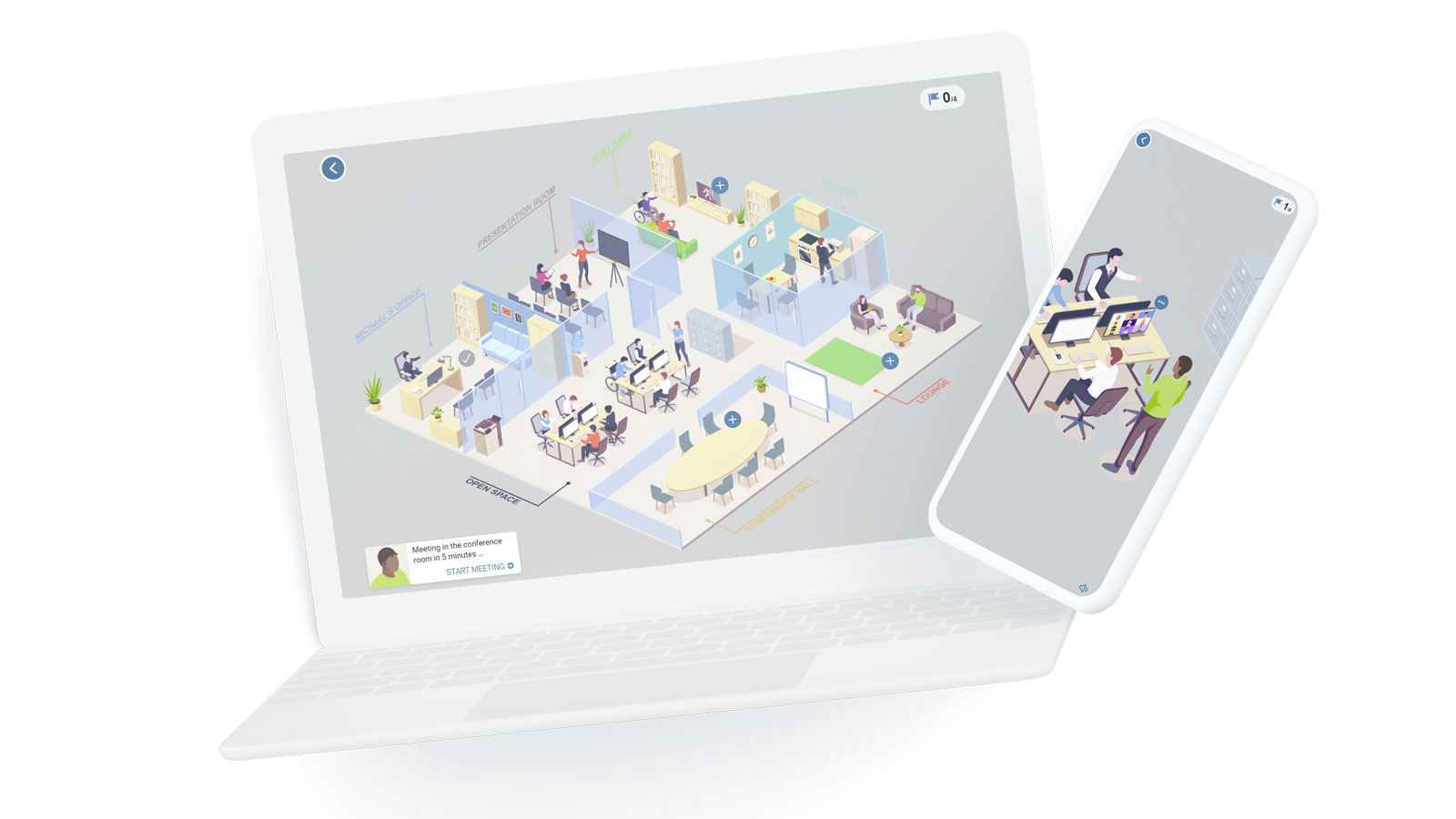
These interactive learning environments are custom developed for each client and brand. Learners can make their own way through the navigation structure and access different items of learning content through jump labels. The result is a digital journey of discovery that is almost limitless in scope. Chatbots, avatars, and dynamic environmental and special-effect sounds can be integrated to reinforce sustained learning effectiveness. Similarly, gamification elements can be added to further enhance learner motivation.
Some applications of learning campaign portals
- Change campaigns: Change campaigns are a way of making lasting change to employee mindsets and corporate culture. The objective is to boost acceptance through learning. That way, employees are more amenable to the proposed changes and more willing to contribute to their success.
- Events: Many organisations use action days to raise employee awareness of certain issues and communicate the organisation’s position on those issues.
- Onboarding and upskilling: Effective onboarding gets new employees off to a good start with the company. It also creates a sense of belonging and instils an understanding of the company’s values and culture.
- Comprehensive learning journeys: Learning journeys put the learner first and offer different learning formats for different topics and learning objectives.

Gaming meets navigation system
The heart of a learning campaign portal is a 2D or 3D map. Alongside its orientation function, the map draws the learner into a fun, game-like journey of discovery. This gamification element is designed to appeal to the young and youthful. However, a good learning campaign portal will be readily accessible for learners of all backgrounds thanks to its intuitive navigation system and quality orientation features.
Example: A company wants to run a six-month sustainability and environmental campaign. The aim is to explain the company’s own position, raise employee awareness, and bring about a mind shift. In this example, the company could integrate a portal upstream of its LMS that guides employees through all learning content relevant to environmental protection.
There are no design limits to how this might be achieved. In the above example, the map through which learners journey could be a rainforest or ocean, for instance. Or perhaps the company wants to present a future vision of its own site or visualise the campaign by means of a custom campus. This level of creative freedom calls for good sparring partners who, for all their love of the product, are always mindful of functionality. This is where our experts come in. They provide comprehensive advice on all aspects and put successful learning front and centre.

The facts:
- Learning campaign portals are not ad hoc solutions – they require a planning and development phase.
- The scope of learning campaigns should be limited either to specific content or specific timeframes.
- A learning campaign portal is not a stand-alone product – it requires a learning system (LMS).
- Independent exploration of a map will enhance motivation.

Development Paths: Moving Beyond Learning Paths
Learning paths have been part of corporate learning for a while, but they’re not being used to their full potential. Learning paths offer more than just a way of providing short-term training for employees; they can be an absolute game changer in the fight to overcome skills shortages.

How Tinder and Netflix are shaping the future of learning
In a challenging environment, corporate learning will remain effective only if it is learner-centric and offers formats that are in keeping with learners’ other everyday digital experiences. This is important because learning providers are no longer competing just with other learning providers; they are also competing with dating apps, streaming services and social media.
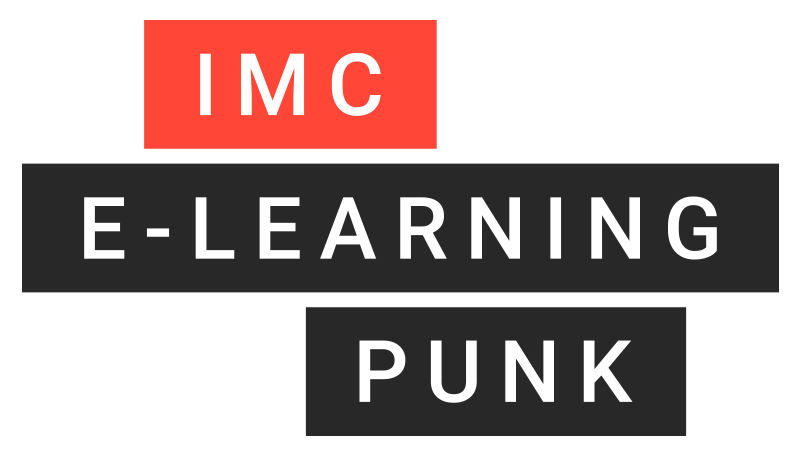
Contact person
I joined the imc newsroom team in 2021. As a journalist my heart beats for content and storytelling.
I’m excited to figure out how e-learing and digitization affect the future of work. My task is to create content to talk about and I’m always looking for trends.
Privately I love to travel and eat Tapas.
Topics: E-Learning Trends, Corporate Social Responsibility, Press and Influencer Relations

an LMS RfP
Compiling an LMS requirements for proposal (RfP)
Are you looking to compile an LMS RfP requirements document to help choose the best training solution for your organisation’s needs?
With hundreds of learning management systems (LMS) on the market today, deciding which one is right for you can be a complicated process. A good Request for Proposal (RfP) can simplify your decision making process by starting off with a training needs and features checklist.
Your choices can then be whittled down to a shortlist of LMS solutions that meet your specific criteria, with a final decision based on which provider you most like and trust.

What's an RfP for learning management systems?
A request for proposal or RfP is a document put together by the client and sent to potential learning management system providers in order to start the conversation about suitability and generating a quote.
A good RfP will contain information about the organisation and its elearning goals, the number of people (sometimes including external partners and supply chain as well as employees) to be trained, existing technology infrastructure to be integrated into, and any other LMS needs and constraints.
LMS providers who feel they can meet these criteria can then send a proposal, and the client can form a shortlist of providers to progress conversations with, and from whom to make a final choice.
Benefits of an LMS request for proposal
One of the key benefits of an LMS request for proposal is that it ensures a level of objectivity in the procurement process. By starting with a checklist of essential, then nice to have features, the client can be more assured of suitability in a learning platform, rather than being overly swayed by slick sales presentations.
Before talking to a vendor, you can define your essential LMS requirements, before going on to list those that would be a bonus but that you may be willing to forego depending on price or strengths in your must-have criteria.
It’s really important to identify which criteria are truly essential to making an LMS work for your organisation, regardless of bells and whistles in nice to have areas. These LMS priorities will help to ensure the project does not fail.
Timescales and budgets
Does your project have a strict timescale and / or budget? If you have hard limits to work within, by making these clear within your RfP you can avoid any time-wasting discussions if a vendor simply can not meet them. It also prevents time and budget creep once a project is underway.
Because the RfP is an up-front piece of work that can be sent to multiple vendors (and there really are hundreds to choose from), you will usually save time overall because you are not having to repeat yourself in initial email and telephone conversations. You can also avoid conversations with and presentations from companies that can not meet your needs.
LMS RfP components
Your document should have 3 broad RfP components, which are:
- Project overview
- LMS requirements
- Vendor expectations
Let’s go into each of these sections in some more detail:

Project overview
This should be a brief (one page should suffice) intro to your project and touch on what you are looking for and why.
What is your current training solution and what is it you’re looking to add / change / improve?
It should include the name and contact information for your project lead so that the vendor can ask any follow-up questions.
It should also include a deadline for the project so that vendors who can not work to your timescale can quickly self-eliminate. Include your timeline for receiving proposals and making a final decision on your vendor.
While you don’t need to go into detail on your company history, its founders etc (by all means link to this background info online), helpful information will include your company’s industry, regulatory environment, number of employees to be trained now and down the line, and geography - especially important if there’s likely to be a multilingual component.
LMS requirements
This is where you get into the detail of what you need from a new LMS and can be much longer than the project overview if you have put together a good list of requirements having had consultations across all your stakeholder groups.
Users
This will be much more numbers-based and touch on:
- Learner roles and numbers within each type - on launch and for subsequent roll-outs
- Geographies and languages
- Number of courses
- Existing and desired training media
- Administrator roles and any relevant hierarchies (an organisational chart may help)
- Potential numbers of concurrent users
LMS features
If you are relatively new to LMS features or you are replacing a very outdated system, you may be fuzzy on potential functionalities within the ideal platform, especially when it comes to terminology.
Feel free to talk here about what you need to achieve with the learning platform if you’re not sure how to define the feature that would make it happen.
Common LMS needs and functions
- Creation of job roles and competencies defined in each position
- Enrolment process on courses, including any combination of self-enrolment, automated enrolment by role or manual enrolment governed by managers
- Multi-tenancy - i.e. creation of tailored, and even branded, learning environments for different teams, including employee types, external partners and even customers
- Assessments and certificates - including quizzes, required competency levels and any legal / regulatory compliance needs
- Reporting tools for administrators and departments such as HR and Legal
- Mobile access - especially important if you have employees on the go who need to access training materials via a tablet or smartphone.

LMS Integrations
It’s rare that large organisations will want a learning platform that operates in isolation these days. LMS integrations with existing HR software such as Workday or SAP, a CRM like Salesforce, and other tools managing employee data can save a great deal of time spent on learner admin.
It can also improve overall business performance by increasing knowledge sharing across your organisation. Define your existing people software where integration could make life easier.
Vendor expectations
Define what you would like to receive back from the vendor. Any experienced LMS provider will have existing templates that they work with and which are often pre-populated to an extent, but you can still request information in a format that suits you.
You may want to request an initial one-page summary of their solution that encapsulates what they can deliver and when, and to what budget. This will make it easier to discuss proposals with your peers and other stakeholders without having to go into the fine detail.
As an LMS buyer, very important information to receive from the vendor includes:
Their company and background
- How long have they been in business? You don’t want to be a guinea pig or deal with an inexperienced team
- How large is their team of LMS developers? While you don’t necessarily need to work with the largest companies and all the overhead costs that come with that, you don’t want the risk of single points of failure that come with working with a small business
- Who are their customers? Do they have experience in your sector and with your company size? If so, this will fast forward their understanding of your needs.
The platform
- Have they ticked all the essential requirements? Don’t let ticking lots of boxes across the must-haves and nice-to-haves cloud your judgement here. A high overall ‘score’ is meaningless if one or to absolute musts are not met - this system just won’t work for you.
- What is the position on data security? Does it meet any specific needs for your industry?
- Technical environment - can it work with your IT set-up?
Budget
- Is the system scalable without additional costs per learner or is it priced per learner? The latter benefits smaller organisations but can become painful for larger ones…
- Is there a separate implementation cost?
- How does ongoing support work and how is it priced?
- Are there update / renewal fees and when are they payable?
- Is user training included or charged separately?
Implementation plan
- Do you start with a limited cohort of learners for user testing?
- What are the various implementation stages and timescales for each?
- What involvement is required from the LMS buyer and at what stages?
Summary
Buying an LMS can be a complicated process - especially when you need to factor in your possible future training needs in addition to your immediate requirements.
By putting together a detailed LMS RfP, you can help to ensure that your procurement will be objective and evidence-based, helping you to avoid costly mistakes and disappointment.
Separate genuine must-haves from nice-to-have features, and you can ensure you meet the needs of all your stakeholders, and that any additional features simply make the new platform more enjoyable and more useful for your business as a whole.
As imc Learning has decades of experience delivering on the training needs of some of the world’s best-known brands, if you’d like to have a conversation about your own elearning project, feel free to contact us for an informal chat.

How much does an LMS cost?
How much does a Learning Management System cost? And which will appear after the implementation? We share some insights and explain, what these questions have in common with buying a house.

Headless LMS – definitely not brainless
In this FAQ we explain the purpose and benefits of a headless Learning Management System. Learn more about headless LMS...

How Tinder and Netflix are shaping the future of learning
The media consumption patterns of Gen Zers call for completely new learning formats – Here’s one we’ve come up with
The media consumption habits of people currently moving into the corporate workforce are very different to those of previous generations. And they are playing a major role in shaping employee expectations around work and professional development. In this challenging environment, corporate learning will remain effective only if it is learner-centric and offers formats that are in keeping with learners’ other everyday digital experiences. This is important because learning providers are no longer competing just with other learning providers; they are also competing with dating apps, streaming services and social media.
One key way of staying competitive in this sense is to develop individualised learning experiences and adaptive learning content. And we have a new tool that can help with that. Introducing the “Readiness Check”.

“We want to be the Tinder or Netflix of learning”
Gen Z has integrated digitalisation into all aspects of daily life, as Dr Robert Lohmann, product manager for learning content at imc, knows full well. “These days, you’re not going to get engagement from anyone by throwing content at them in the form of outmoded training courses,” he says. “These sorts of courses were all well and good at the time, but now they are no longer enough. And that’s why we’re increasingly working with elements and features that are familiar from other digital domains, such as chat bots, swiping in dating aps, and content recommendations of the kind used by streaming services.”
Companies, including their learners, want customisation, but they don’t want to pay the earth for it. Hence the growing demand for off-the-shelf learning content.
But even with off-the shelf content, adaptive learning and individualised learning experiences are an absolute must if you want to engage with the new generation of learners. “That was the big challenge here: to create off-the-shelf training content that is generic enough to be useful to a wide range of users while still offering individualised learning,” Lohmann explains. “And that’s what we achieved with our Readiness Check in the case of our awareness game Cyber Crime Time.”
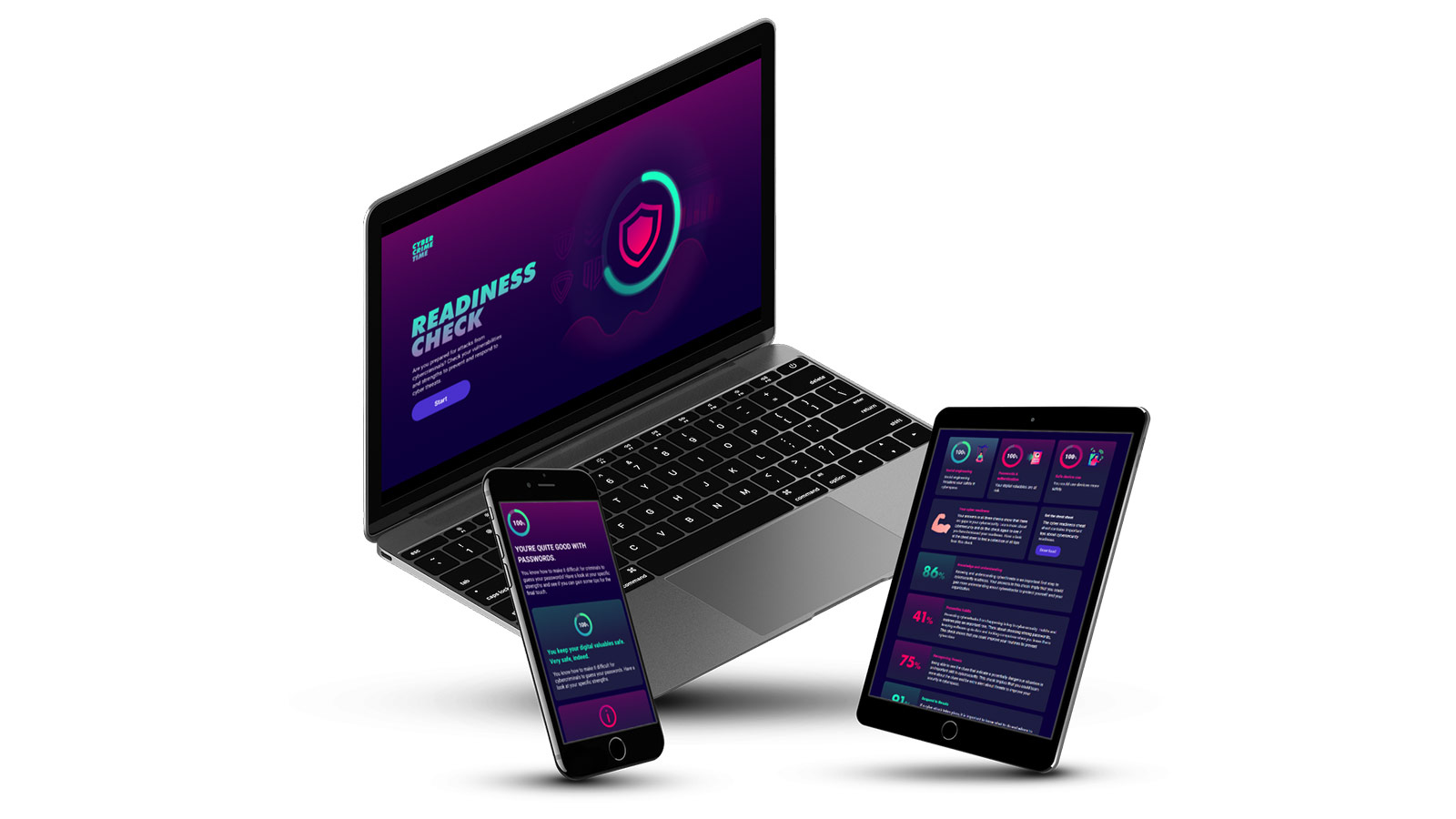
Using the Readiness Check to make learning experiences more customised
The Readiness Check enables companies to build up a highly granular picture of their learners’ current level of knowledge so they can tailor an appropriate response. In all likelihood no two users will ever receive exactly the same feedback when working with the Readiness Check. So, how does it work?
Timo Paul, a senior frontend developer in our content department who played a major role in developing the Readiness Check, explains: “It works by assigning a numeric value to each of various defined learning categories. The numeric values themselves are variable, so they can be specific to the learner. The response yielded by the Check is thus highly customised and can comprise anything from simple feedback to activity or content recommendations all the way through to further training courses or learning nuggets. There are no limitations, and that’s what makes this tool an attractive option for creating customised learning experiences.”
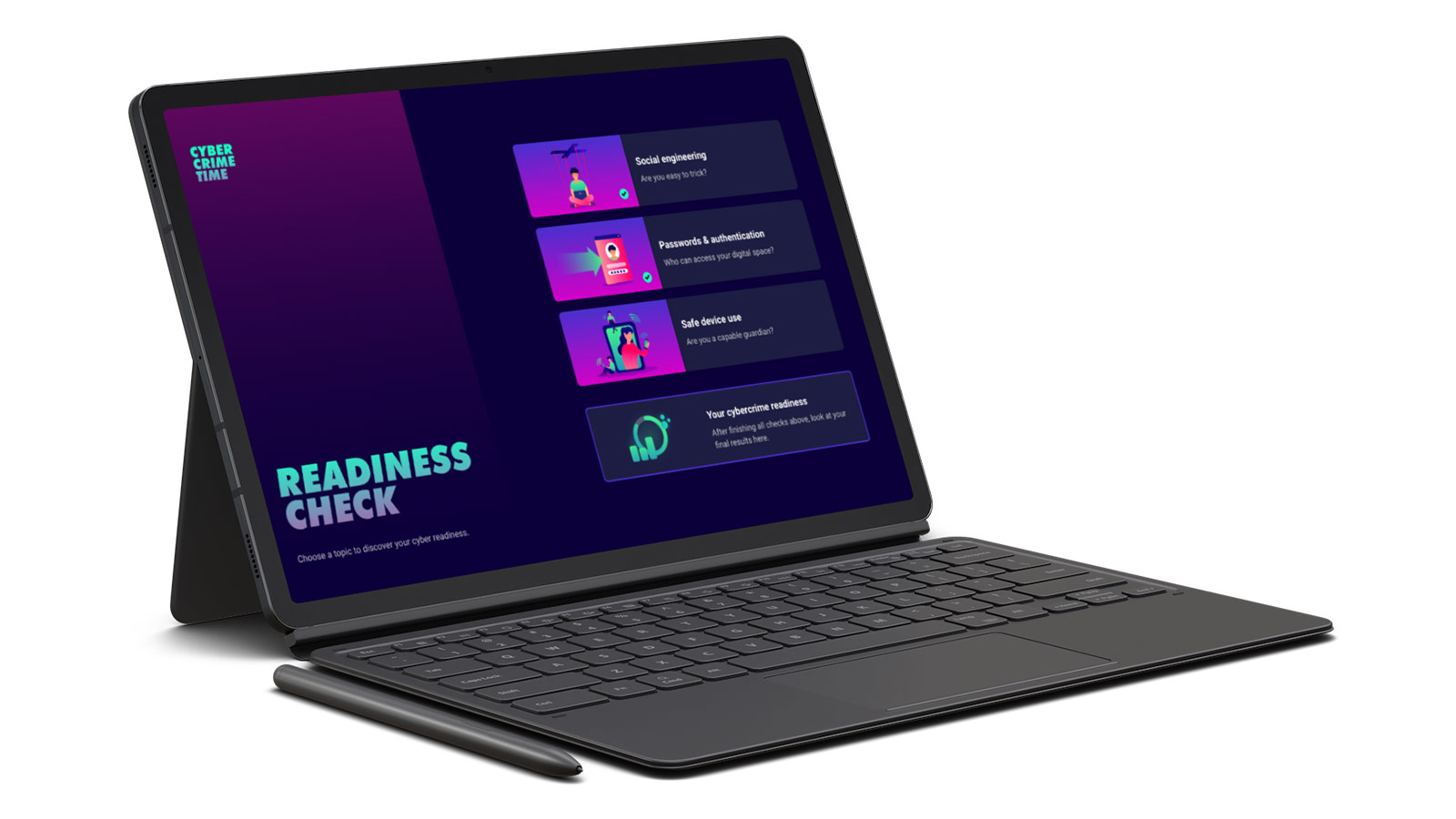
The tool can even be used with very broad learning domains simply by aggregating multiple Readiness Checks into one overall Check, as Timo Paul explains: “It’s a bit like a general knowledge quiz, where you poll the subject’s knowledge in multiple categories and hence arrive at an individual result for each category. The technology behind the system then compiles the results of the individual categories to arrive at an assessment of the subject’s general knowledge.”
It’s all in the weightings
By now, some of you have probably concluded that the Readiness Check uses some form of AI. And you’d be wrong. It uses something even better than AI: humans. The people who configure the Check specify the weightings that lead to the final result. In other words, they determine the numeric values of the individual answers or categories within the Readiness Check, which enables them to make a qualitative assessment of the learner’s existing knowledge.
The overall result is not based solely on the number of correct answers, but also on the weightings that have been assigned in the background. “That’s what’s new about the Check,” Timo Paul explains. “We supply the tool, and then the person responsible for training content works with us to set the tool up so that it meets their needs.”

Cost savings through individualised assignment of learning content
Last year, imc wowed the market with its award-winning “Cyber Crime Time” cyber security awareness game. So, it made sense for the company to integrate this new learning format into its own in-house premium training. And it did this using the Readiness Check. “The development work we did for the Cyber Crime Time Readiness Check was a valuable learning experience for us,” Dr Lohmann says. “It involved developing something in-house and then testing it over and over until we were happy with the result. And that result is the Readiness Check. It’s been a big help for us, and our clients can now benefit from it too. A lot of blood, sweat, tears and time has gone into getting this tool just right, and now it’s ready to go.”

Ready to go!
But the two categories can also be combined to leverage their strengths, Härle explains: “There really are no limits! With an individual learning journey, off-the-shelf content might, for example, be included as learning nuggets. Our objective is to create off-the-shelf content that feels nothing like off-the-shelf. Cyber Crime Time, the Journey, is a prime example for this.”

The Netflix Factor in Self-Directed Learning
Self-directed learning and Netflix have a few things in common! We find out what, how it can be used in companies and where the limitations lie in corporate learning.

Off-the-shelf content has come a long way from being an uncomfortable compromise
Costum or off-the-shelf training content - which should you choose? You should first ask yourself: Is the training need or problem I have very specific? Or is it something that many different people in different industries need training on?

Contact person
I joined the imc newsroom team in 2021. As a journalist my heart beats for content and storytelling.
I’m excited to figure out how e-learing and digitization affect the future of work. My task is to create content to talk about and I’m always looking for trends.
Privately I love to travel and eat Tapas.
Topics: E-Learning Trends, Corporate Social Responsibility, Press and Influencer Relations

Diary of a Learning Management System
imc Learning Suite: Six pro tips to make your life easier when working with the LMS
Ever had words with your car? Yelled at the TV? Sworn out loud as you stab angrily at your PC keyboard? Or muttered “stupid system!” – only to discover, somewhat sheepishly, that the problem lay with you, not the system? It’s OK, we’re no different. Our consultants are intimately familiar with this phenomenon, too.
That’s why we talked to our consultants about the misconceptions and obstacles that most frequently cause LMS clients grief, and how they can be overcome. And sometimes it’s good to see things through the other person’s eyes, so we’ve decided to write this from the point of view of our learning management system and share some tips for a better handling of the LMS. That’s right, you may not be aware of it, but our LMS has feelings too, and it’s only trying to help!
The following excerpt from the diary of our learning plattforn is a light-hearted take on human-system interaction, but it contains genuine and practicable expert advice that will hopefully make working life less stressful and more relaxed for all concerned – you, the system, and our consultants.

Dear Diary,
8 a.m.: Dealing with a sudden mass influx of visitors
This morning, I wasn’t even fully awake and was hoping for a slow start to my day, but then I received another error message from China. It was from that important guest who checked in recently. Humans, by the way, always call guests “clients”, but “guests” sounds so much nicer to me.
Anyway, this super-important guest thinks it’s okay to check in an additional 50,000 learners without first telling us and giving my human colleagues – imc’s consultants and architecture experts – a chance to make the necessary server preparations. These preparations are quick to implement, but they’re not instantaneous. I mean, have you ever tried to find room for 50,000 guests who show up on your doorstep unannounced? We pride ourselves on being great hosts, and part of being a great host is being prepared.
Pro tip 1:
If you know you are going to need a large volume of additional licences, please give the consultants in charge seven to ten days’ advance notice.
Note: This does not apply to completely new clients or enterprise groups. In these cases, the preparations take an average of three months, as the process is a lot more involved.
12:15 p.m.: Bugs vs. user errors: Banishing misconceptions
My personal coach, Lia, always says I need to work on my stress management – it was her recommendation to keep a diary. I like Lia. She listens and helps me manage my endearing little peculiarities – the things that humans for some reason call bugs.
Bugs! Such an unkind word to use, given that everyone has their little quirks and tics. And to be perfectly honest, many of so-called bugs are not actually my fault, they’re user errors. There is always potential for user error, which is why my human colleagues and experts – wonderful people like Andreas and Christian – are there to help. They are excellent human-machine interpreters and are only too happy to clear up these sorts of little misunderstandings and misconceptions.
Pro tip2, for system administrators
Please do the user training sessions with our consultants and refer to the relevant training documentation. It will save a lot of time, boost productivity and reduce stress. That’s a promise!
1:00 p.m.: How gamification boosts motivation and enhances learning outcomes
It’s so pleasing to see that my new functions are being accepted and used by more and more guests. And to think that only a couple of years ago, they still had to log in separately to every system I’m connected to. Such a chore and a bore! But now, thanks to single sign-on authentication, it’s all so much simpler, and they can now access the entire learning ecosystem with a single click.
A lot has happened on the gamification front too. Being able to collect badges after completing courses is extremely motivating and makes learning much more fun. Up until quite recently, gamification tended to be frowned upon, especially in the more staid German companies. They’re supposed to be learning, not playing! Well, I disagree, because I can combine learning and play.
Successful learning comes from motivation, which is why I wholeheartedly recommend my skill management feature. With skill management, I can facilitate employee development by highlighting the skills employees already possess, and those they are yet to acquire.
The employer can then compare this information with the skill requirements in job profiles to identify which candidates still need development in specific areas, and which ones are suitable for the role because they already have the required skill set. This can be applied to all selection scenarios, from promotions to filling vacancies. I firmly believe that not using this feature is a wasted opportunity, particularly for guests who have a lot of office-based employees.
Pro tip 3
Don’t be afraid to move with the times! E-learning is so yesterday. Today, it’s all about creating unique learning experiences. Whether it’s small hacks, the use of gamification, or skill management, your employees will not only love it, they will become more productive.

3:30 p.m.: Using Netflix-like features to create unique learning experiences
Time for a coffee break, time to share a little secret: I will soon be getting some amazing new functions. And the best thing about it is that people are comparing me with Netflix – finally, a function that’s instantly recognizable for every user! Very clever of my developers to have come up with this: my new ability to recognize when different items of learning content deal with related topics. I can now recommend new courses or learning videos based on these similarities.
I can’t wait to see how this function is received once the first guests start trying it out. Who ever said learning systems are unsexy?
Pro tip 4
You should definitely check out the new channel function. Channels not only look great, they transform learning into a real experience.
3:45 p.m.: Courses and learning paths made easy
That’s my caffeine fix sorted. Time to move on to the next real challenge – in the form of a new guest from Australia. This guest creates three new courses, then complains that there’s no easy overview of who has done the courses or completed the tests.
But that’s another major misconception, unfortunately, because the solution he needs is already there: learning paths. Let me explain. First of all, there’s learning content. That can be any kind of training, whether face-to-face or digital. If I combine multiple items of content, then that’s a course. I can then combine multiple courses to create a learning path. If I want to, I can then also define various course prerequisites.
The idea of prerequisites is that the learner can’t progress to a higher-level course until they have passed the courses below it. You can even create placeholders – course templates – for individual courses in the learning path if, say, the course dates have not yet been finalized. Guests can then book the relevant courses in the learning path once the dates have been finalized, and the courses created. With this set-up, the administrator will always have total transparency regarding how far along the learning path the individual learners are, and can see full details of the courses.
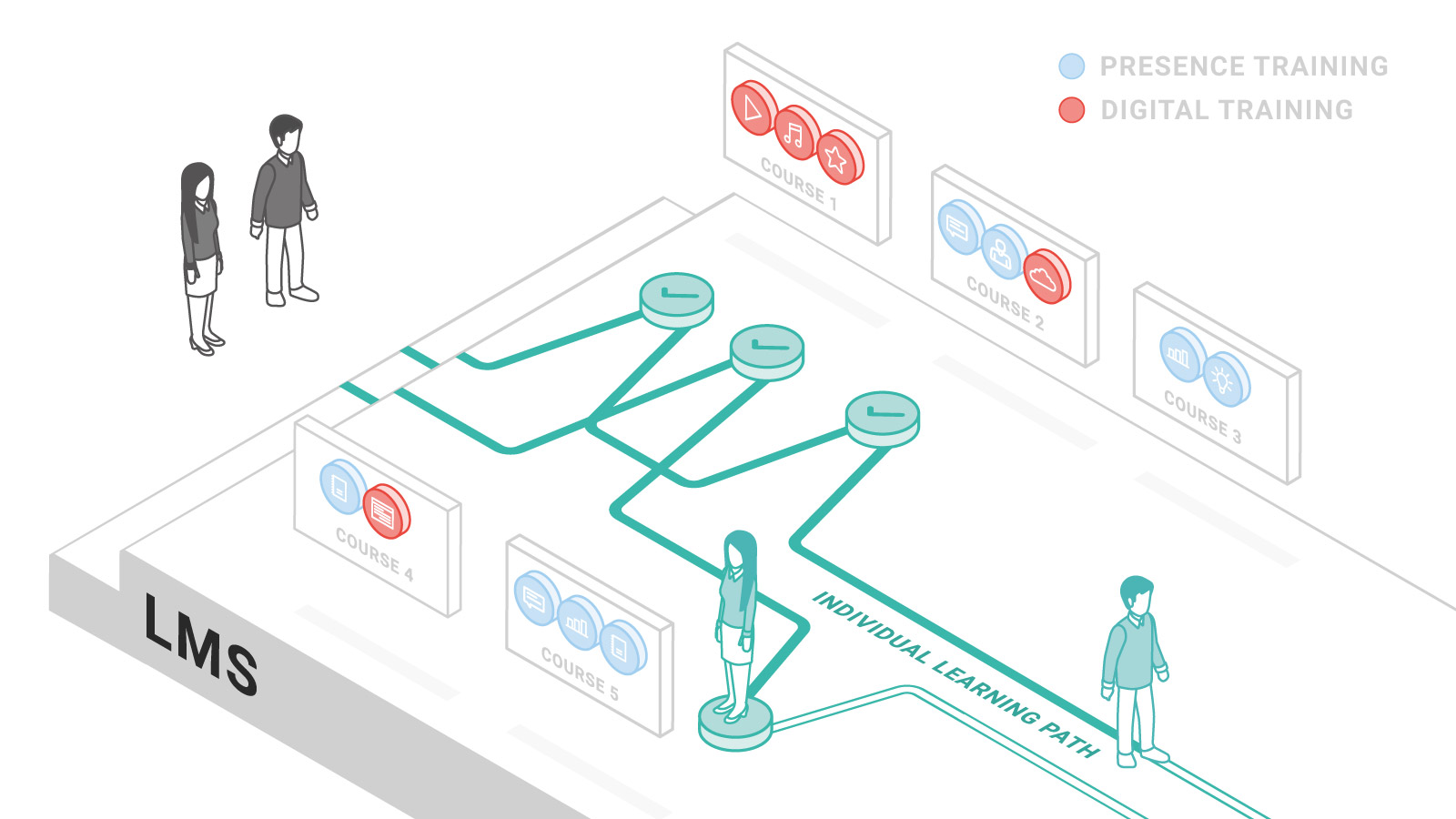
Pro tip 5
Learning paths need to be well thought out because they are intended for longer-term development programmes. In that sense, they are like semester schedules at universities. The latter comprise various lectures or courses, and by the end of the semester, students need to have attended all the lectures in order to pass.
So, it’s important to think carefully in advance about the purpose for which an item of learning content, a course or learning path is being created. Once you have created a learning path, it’s not that easy to make changes. If you are unsure, it’s best to double check with our consultants.
5:00 p.m.: Smart decisions with learning analytics
What a day! But the end is in sight. Meanwhile, there’s something I really want to get off my chest: I’m a precision system, and I can show humans exactly what they want to – or are allowed to – see, but only if they correctly specify what they want via my user interface.
The same principle also applies to authorisations. It makes total sense that sales consultants who only sell, say, drilling machines should not need access to user guides for gardening tools. But to give effect to that, you actually need to specify it in the roles and rights concept. That way, the group defined as “sales consultants for drilling machines” will only be able to view user manuals for drilling machines.
Also, my creators are constantly talking about learning analytics and how it can be used to create really cool dashboards. That’s another new functionality that I’m very proud of. Learning analytics enables you to “measure the business outcome of the learning process,” as my big boss and Head of Product Management here at imc, Wolfram Jost, would say. In other words, learning analytics lets humans track whether they are getting a good return on their investment in learning. Definitely a key technology to keep an eye on!
Pro tip 6
To get the right answers, you have to ask the right questions, so, if you would like to make purposeful use of learning analytics, it’s worth talking to a data expert or asking our consultants about targeted training courses.
6:00 p.m.: Performance review and new developments on the horizon
Well, it’s nearly time to finish up for the day, and I’ve got a really nice evening planned. The product management team will be coming by shortly, and I’ll be paying really close attention to what they say, because it’s about my future. I love my product managers because they’re always checking me over closely to spot untapped potential and find ways of making me even better than my competitors. Time to grab some data snacks, sit back and relax. I can’t wait to find out what updates they’ve got in mind for me.
Ok, Diary, talk to you again tomorrow!

Learning Ecosytem: A universe of Learning
If you want to use a learning ecosystem successfully in corporate learning, the technical requirements must be right. Time to shed light on what systems have to fulfil in order to be able to meaningfully map a genuine learning ecosystem.
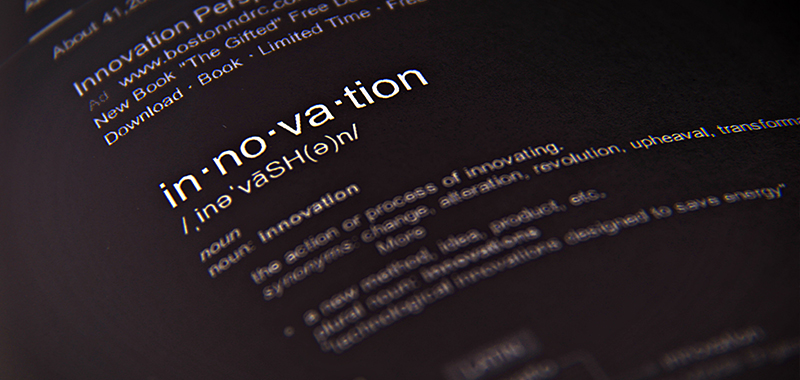
The Ultimate eLearning Jargon Glossary
LMS, LXP, SCORM, WBT, EPSS, NGLE, CBT, ITS!? Lost in a world of elearning terms and abbreviations? No worries, we can help. In this A to Z, we shed some light on the subject and have compiled a list of the most important terms and abbreviations in the field of e-learning in 2022.
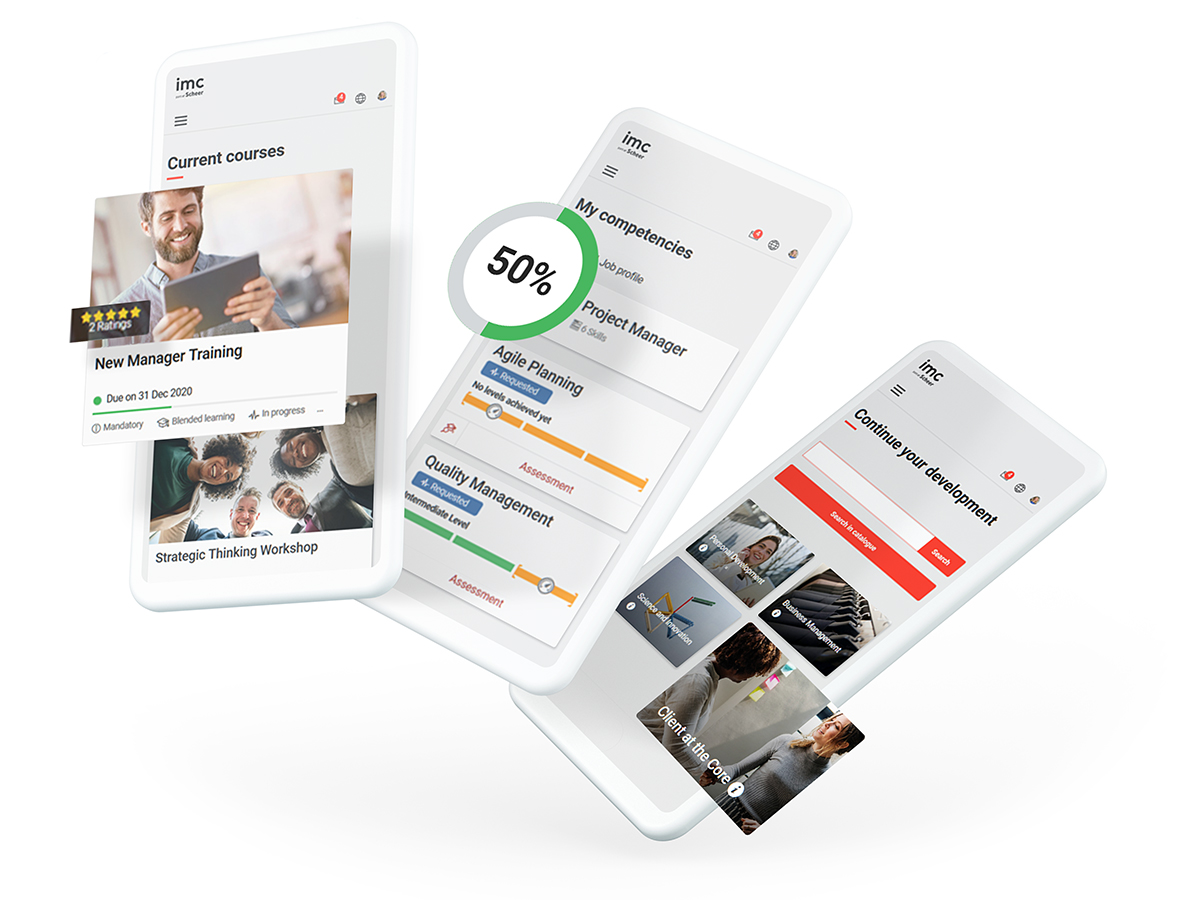
More about our LMS
If you would like to learn more about imc's Learning Management, check here for more information.

Contact person
I have been working in the Marketing & Communication Team at imc since March 2019.
Communication, creative content and social media are my passion. "KISS - Keep it short and simple" is my credo.
To explain complex content in an understandable way and thus make the topic of e-Learning accessible to everyone is an exciting challenge every day.
Privately I love to read, play poker and travel a lot.
I am always happy to receive feedback or suggestions.

Increase Customers Live Time Value and Earn Their Loyalty
Here we look at how to improve customer service, retention, satisfaction and live time value with Customer Education.
Business leaders know that, on average, it is 5X more expensive to acquire new customers than it is to retain existing ones. Furthermore, it is usually far more profitable to upsell and cross-sell to existing customers than it is to simply increase your number of customers.
Customer education can be a powerful tool in helping you to build trust, retain existing customers and ultimately, increase customer lifetime value (LTV).

What is Customer Education?
Customer Education is learning content designed to engage new or existing customers and help them to maximise the effectiveness of your products and services.
When it's done well, it can help to reduce customer service calls and in turn, reduce costs. It can help you to retain existing customers, and even turn some of them into enthusiastic advocates of your brand.
Customer education, also known as customer training, is so important that, according to a Salesforce survey in October 2020:
“80% of customers say the experience a company provides is as important as its product or services.”
Customer education tends to be most relevant for product-based companies, whether that’s physical products or software. It can be of most benefit if your product:
- has a learning curve, where it’s common for customers to make mistakes or get stuck
- requires people to change existing behaviours
- generates frequent customer support calls
- is used by people with a wide range of needs or in diverse contexts
- is updated regularly with new features (very common in software)
- lends itself to cross-selling or upselling (customer education can be a great sales tool!).
While customer education can be delivered face to face, online training enables any time, anywhere learning that is accessible at the user’s convenience. The Covid-19 pandemic greatly accelerated the trend towards online, helping many companies to deliver up to date content even when face to face was not possible.
Online customer education provides greater opportunity to deliver training across multiple formats, including any of:
Video guides
Hosted on platforms like YouTube or Vimeo, or on your own learning management system (LMS).
Live or recorded webinars
Guide new, existing or potential customers through your product usage. When live, you can respond to any questions on the fly, and for those who want to watch it later, the recorded version can act as a useful, video-based FAQ resource.
Infographics
An engaging, fun way to present facts and figures in a creative manner.
Slideshows
A common way to quickly convert traditional, face to face presentations into an always-accessible digital format.
Games and quizzes
An excellent way for customers to test new knowledge and see if they need to return to materials or seek additional support.
Customer Education Benefits
This can greatly reduce the cost associated with large support teams and the frustration customers feel when waiting in queues.
Customers get up and running with your product quickly because they have learning materials to hand if, as and when they need it most.
A huge issue in the field of IT and software products, which inevitably come with some learning curve. Most IT implementation projects fail, not because of a weakness in the product itself, but due to inadequate customer training and in turn, user adoption.
The point at which customers are engaging with your product is often the best opportunity to highlight your related products and services. If you can win their trust in and enthusiasm for Product A and make the customer confident that they can use it, that’s a great time to draw their attention to Product B, C, D….
This is frequently the greatest benefit to a good customer education programme. A customer who is happy with your solutions because you helped them to maximise the value of it, is much more likely to renew or upgrade when the time comes.
So clearly, there are numerous benefits to making training available to your customers, but how to make this easy and cost-effective? That’s where a customer education platform can make things efficient and highly scalable.
Customer Education Platform Features
The best customer education platforms will help you to not only upload training materials to make them accessible online, but will offer a range of useful features and attributes that include:
- Integrations with popular software products like eCommerce payment gateways (such as PayPal) or CRMs (such as Salesforce) to reduce admin, while ensuring data security.
- Scalability: You’ll want your platform to handle a growing customer base, and not become a limiting factor.
- Multilingual capabilities - if you run an international company, you’ll want to make eLearning content available to customers in multiple languages
- User analytics: Data and reports will help you to learn what content and formats are engaging your customers and where people seem to struggle or switch off. This can help you identify weaknesses in your learning materials - or even the product itself. It can also help you to intelligently signpost customers to areas of your platform for additional support.
Well-designed training materials that are kept up to date and made available via a good customer education platform should be seen as an investment in customer success, retention and new business development, rather than just a cost.
Guiding users in making the most of your products should deliver increases in customer lifetime value / LTV, win you new fans, and strengthen the reputation of your brand.
Happy to help
For 25 years, imc Learning has created eLearning solutions for customer education and staff training at companies and public sector organisations across the globe.
Our clients include the likes of Deloitte, Vodafone, BASF and Audi.
If you’d like an informal chat about how we could help you leverage customer education to improve customer service and retention, get in touch with us here at imc Learning.

LMS for Membership Organisations
Make an effective LMS platform for your membership organisation with key features such as eCommerce, adaptive learning and analytics.

Learning Ecosystem: A Universe of Learning
Create a learning ecosystem in the LMS that promoted self-directed learning in the long term.
Contact person

Learning ecosystem: A universe of Learning – why you need it, how you build it
Discovering new worlds of corporate learning
The L&D sector has largely reached a consensus: Customisation must play a bigger role in corporate learning. We must strive to democratise knowledge. The panacea needed to achieve these ambitious goals? A learning ecosystem. The focus is almost exclusively on soft factors related to the corporate and learning culture when establishing such a system, neglecting technological aspects.
Yet, suitable software such as a learning management system or learning experience portal is vital. Let’s take a step back to grasp what a system needs to achieve to map a meaningful learning ecosystem.
Inflexible systems and uniform learning paths for all employees are a thing of the past. Nowadays, companies face the challenge of creating a learning ecosystem that promotes self-directed corporate learning in the long term.
Such a system links various platforms and creates a clear structure for the different formats within a learning portal. The search function leverages all integrated systems, taking account of both internal and external sources.

Andreas Pohl, Director Research & Development at imc
So much to the theory. The question now is: What technical structure enables a learning ecosystem to meet all requirements and offer real benefits to the employees?
What role does a learning management system (LMS) or learning experience portal (LXP) play within such learning universe?
imc expert Andreas Pohl, Director Research & Development, leads the development of such systems. Thanks to his many years of experience, he is very aware of the hidden potential learning ecosystems offer.

Hello Andreas! What would a learning ecosystem look like in practice? Can you give us a specific example?
Let’s say we have an industrial client who manufactures special parts for large-scale equipment. All new employees and trainees must know how to use the equipment employed to make these parts.
They train on a training machine to learn the workflow. Now, it is possible to link this training machine to a learning management system (LMS). In that case, a new employee could log into the training machine with their personal identifier. Once they have mastered the workflow, the machine automatically transmits the training success to the LMS where the training is marked as complete.
This is then booked in the employee’s learning path or as learning progress – for instance, as part of their on-the-job training. Thus, the communication between the different systems makes learning easier. This example might be a little staged, but I think it illustrated the practical application of a learning ecosystem very well.
What does a learning ecosystem need to do to make learners use them?
Before you start thinking about a learning ecosystem, a suitable cultural framework must be in place.
As an employer, I need to motivate employees to use a system and allocate time for that purpose. At the same time, the user experience of the learning ecosystem (LE) must be structured in such a way that the employees enjoy using it, and make it easy for them to find relevant content.
A user will be far more likely to use the system when they can see an immediate and direct benefit. If that benefit is not obvious, you have lost.
How do you realise that from a technical perspective?
There are two approaches: First of all, I can make the LMS or LXP the central hub for my learning ecosystem. In this case, the LMS also needs to be able to present contents from external sources.
The learner can find materials from the entirety of the ecosystem through the frontend of the LMS. It makes no difference to them where learning content is stored – in the company LMS or, for instance, an integrated content library. For the learners, it is important that the system is easy to navigate and that they can quickly find relevant contents without jumping through hoops. Whether or not this takes them into a different system is irrelevant.
The second approach is to subordinate the LMS to the overarching portal. Rather than being at the centre itself, it delivers its results to the top level. This is useful when a central portal already exists and the LMS is integrated at a later stage.
How does an LMS become part of a learning ecosystem? What are the prerequisites?
In the second case – when the LMS is a cog in the wheel – the contents must be supplied to the overarching system. Indexing then becomes a major factor. That means that content must be provided in a format that triggers useful search hits presented and shown in a meaningful manner. The same applies to recommendations the system gives the user based on learning habits or interests.
Good APIs (application programming interfaces) are the key success factor for these types of functions. They facilitate the communication between the different applications. Effective and standardised interfaces are always important in IT, but whenever several systems come together, they become absolutely crucial.

How does an increase in content affect the individual interfaces and components?
This is a very interesting question. Let’s break it up into two parts. To illustrate: Your universe might grow because the number of planets is increasing, or because the existing planets are becoming more populated. These are two very different scenarios.
Similarly, you can expand your learning ecosystem by integrating or linking new components, or by adding more content to the existing elements.
After all, the purpose of a learning ecosystem is to continuously and frequently change the volume of the learning content, and the integration of user-generated content (UGC). Going back to our analogy, user-generated content merely increases population density on a given planet. From a technical perspective, this is not a critical process, as the growth takes place within an existing system with no effect on the complexity of that system. It would therefore not qualify as a true expansion.
So, what is “true” expansion? What do we have to watch out for?
I would say a true expansion of the ecosystem involves the integration of additional systems or a new interface. This expansion process is somewhat slower, as each new system needs new interfaces or gateways.
Each “planet” needs to provide the information within the LMS to the other “planets” – and ultimately the user – through standardised interfaces, and various APIs as well as an event bus are utilised for this purpose. Meanwhile, the central system must be able to absorb content and integrate it in its search function to make it accessible to its users.

How does the system know which content should be shown?
The system can only show content it knows. That means either the index content must be transmitted to the system – for example, via a data or event bus – or the system must have direct access to the index. Naturally, this can only work if indices are properly maintained and clearly structured.
What role does the data or event bus play?
An event bus is basically a messaging system. One system throws a message onto the bus, the bus takes off, and the next system can retrieve the message.
The message does not disappear after it is retrieved by one system – it remains available for the other systems. For example, systems A, B and C “take” the message, but system D ignores it, because it’s not relevant to it. Meanwhile, system D might “take” a different message that A, B and C are not interested in. Messages are thus distributed in real time, making manual message transfer to each system redundant (publisher-subscriber approach).
The challenge with this approach is that each system involved must be able to understand the message contents. This often requires some adjustments, as some systems might not be able to translate it directly. This is a major current topic for our development team.
What trends would you say can make learning ecosystems even better?
There is certainly room for improvement in system alignment, which also encompasses IoT (internet of things) and ESB (enterprise service buses). In other words, systems need to know both, which message they need to retrieve from the bus and which immediate adjustments they need to make.
This reduces the need for system adjustment. Now, an ESB is not a trivial thing, and might be overkill for a straightforward set-up with a small number of systems. However, my learning ecosystem is fairly complex and serves more than 10,000 employees, it makes an enormous difference.
Another thing we are working on at the moment is switching over to external contents. Right now, we can integrate external content in the search through our LMS, for example, through the LinkedIn Learning Content Importer. We want to expand that capability to enable the user to switch directly into the external system. We are currently collaborating with a major client to achieve that.
Finally, what should we pay particular attention to? Where do you see the most potential? Are there also disadvantages?
It comes at a cost. None of this is free. Everything we talked about needs investment. The systems need to be maintained continuously, as do the connections to the interfaces, and some of these systems might be proprietary. It’s not an automated process.
Ideally, that will enable me to create a learning ecosystem which optimises how the different needs of all my learners are met. Everything then comes from a single source, which is a whole lot more user friendly and actually feels like one system. A good learning ecosystem goes a long way towards improving the learner experience and providing real support to employees in their daily work.
My advice: Good planning is half the battle! It is important to clarify from the outset what you want to achieve, how many systems should be maintained and how much maintenance can be provided.

How not to break bad with validated processes in an LMS
What requirements must an LMS map for validated processes? And how does Breaking Bad fit here? Questions about questions not only the Pharmaceutical industry should think about.

Learning Analytics: It comes down to the right questions
Learning must not be an end in itself, but fit in the company’s business outcome: More and more managers are demanding this. We therefore looked at how L&D managers can meet this requirement with the help of Learning Analytics.

More about our LMS
If you would like to learn more about imc's Learning Management System, check here for more information.
Contact person
I have been working in the Marketing & Communication Team at imc since March 2019.
Communication, creative content and social media are my passion. "KISS - Keep it short and simple" is my credo.
To explain complex content in an understandable way and thus make the topic of e-Learning accessible to everyone is an exciting challenge every day.
Privately I love to read, play poker and travel a lot.
I am always happy to receive feedback or suggestions.

Learning Management Systems for Membership Organisations - Key Features to Look For
Here we look at the unique requirements you should look for in a learning management system (LMS) for membership organisations, in order to make your platform effective for current and future training needs, while improving many other aspects of member administration.
Over the last few years, many professional bodies and trade associations have added online training, services and member benefits via an LMS to supplement their offline offerings.
However, as everyone is becoming more tech savvy and comfortable in doing more of their business and social networking online, many membership organisations now conduct the majority of their communication via an LMS or online portal, with some even being primarily or entirely run online.
Add to this the need for social distancing and remote communication while the coronavirus pandemic continues through 2021, and many membership organisations need an online hub to be able to function at all.
Often, generic LMS solutions can technically be adapted to meet the needs of a membership organisation with some custom development work. However, choosing one that has this use case catered for by design (rather than being very focused on training internal company employees) can save a lot of hacking around and headaches.
At imc, our Learning Suite has been developed with membership organisations as a key user-type, making it easy for administrators to organise training, certifications, CPD / CE, online communication and much more.

LMS key features for a membership organisation
These are some of the key features we have worked to continually improve, and that we recommend you look for when choosing the best LMS for a membership organisation like yours:
CPD / CE
Many professional membership organisations require a level of Continuing Professional Development (CPD) / Continuing Education (CE) for members to demonstrate their commitment to staying up to date with the latest industry information and best practices.
Therefore, a good membership LMS will help both users to follow and record any points-based training, whether conducted online or offline, while enabling administrators to signpost suitable courses and content.
Social Learning
While the typical LMS for employee learning and development will be set up to deliver on the top-down training requirements in line with a company’s business and compliance needs, many people join an organisation for the benefits of expert instructor and peer to peer support.
Therefore, a membership LMS should facilitate group chats, threaded discussions, and many of the content liking, sharing and commenting features that users will be familiar with from social media platforms like Facebook, Twitter and LinkedIn.
Multi-Tenancy
Membership bodies, especially larger organisations, may have multiple types of learners, each with their own needs in terms of features, as well as content. For example, there will be the members themselves - who may form one or more type - there may be the organisation’s own staff who need training and their own ongoing support and development, and there may be external partners, such as affiliates and 3rd party training companies.
A multi-tenancy LMS like imc Learning Suite allows you to use a single learning platform instance to create distinct learning environments for each of your audiences. Each group sees only their self-contained learning experience, which can be tailored to their needs in terms of content, hierarchies, active features, and even branding.
Learn more about multi-tenancy here.

Low-Cost Scalability
Many trade associations and membership organisations, including some of our clients, have tens or even hundreds of thousands of members. Therefore, you’ll want to make sure your LMS can scale with you to large numbers of members without costs spiralling out of control.
Unlike online training for company employees, many organisation members will need to stay enrolled but may be relatively passive - perhaps not active at all for many months or longer.
Therefore, the pricing model used within an LMS for membership organisations should be tailored to or flex to reflect that lower level of resource usage seen within a typical corporate LMS that will be priced based on users / active users.
Software Integrations
Of course, there are many moving parts within a membership organisation, with training being just one of them. Admin time is therefore a potentially big expense, so management of member data should be as seamless as possible across software platforms for CRM, email, video conferencing, finance, multimedia content and more using APIs.
For example, imc offers easy integration with popular 3rd party applications such as PayPal, Shopify, GoToMeeting, Microsoft Teams, Linkedin Learning and Salesforce.
It’s this streamlining of software products that enabled the RIBA (Royal Institute of British Architects), who have 47,000 members worldwide, to go from 5 different systems for attendance bookings, training content, email notifications and more to managing everything within their LMS.
Adaptive Learning
Keeping content relevant and fresh is key for learner engagement with your content. Adaptive learning capabilities within your LMS helps to intelligently assess learners’ existing competencies as they progress through training content. It will guide them to what they need to learn and improve on, and reduce the repetition and frustration that can come from ploughing through training where they are already capable.
eCommerce
LMS ecommerce functionality enables a membership organisation to deliver self-service enrolment, and purchase of individual or group courses, event attendance and more.
For larger organisations especially, this can greatly reduce admin overhead and bring significant cost savings. Look for integrations with popular ecommerce payment gateways, such as PayPal and Shopify.

Virtual Conferences
Prior to the Covid-19 pandemic, many events were already moving to a hybrid model in order to reduce the need for travel and open themselves up to a much wider audience.
Having virtual conferencing capabilities within your LMS allows you to quickly and easily set up and deliver tradeshows and member events at a fraction of the traditional cost and logistics. They can even be recorded and made accessible for any timezone, and open up discussion forums in moderated groups.
Content Creation Tools
Specialist learning and development teams will often create elearning content with popular software, such as Articulate, and make it available within the LMS. However, a membership organisation will often have tens or hundreds of subject matter experts who could be sharing their valuable expertise with the community.
An easy to use learning content development tool, like our own imc Express, can enable experts with no formal learning design experience to create and share training materials all within the LMS ecosystem. This can greatly reduce the time and expense of rolling out new training.
User Hierarchies
A large membership organisation will often have various levels of management, and local area leaders governing and supporting members within their group.
An LMS that is purpose built with membership organisations in mind will allow you to easily create hierarchies with differing levels of permissions, reflecting your own organisational structure.
Analytics & Reporting
Many membership organisations will have one or more overarching objectives supported by projects and events running across a year. A good LMS will enable you to easily create custom reports, giving you clear visibility of progress against overall and group targets.
Detailed analytics will enable you to laser in on groups or individuals that need additional support, as well as high-performers who could be earmarked as future leaders.
How we can help membership organisations like yours
If you’re involved in the running of a membership organisation and are looking to improve training delivery or reduce the time and expense of managing multiple software platforms, then the above checklist of features could help you leverage an LMS.
With the imc Learning Suite, we’ve helped a wide range of membership organisations, such as the ACCA (Association of Chartered Certified Accountants) and the Australian NRL (National Rugby League) to manage many areas of their member administration - not just training - all within the single ecosystem of their LMS.
If you’d like to discuss how an LMS could benefit your organisation too, contact us at imc for an informal chat about your requirements.

Multiple portals, one system
A multi-tenancy LMS is a single learning management system instance that serves various learner groups with differing training needs.

Training external audiences
The concept of training external audiences like members, is often referred to as Extended Enterprise Training. But what is an extended enterprise?
Contact person

Why companies cannot afford to skip training their external partners
Only considering your own workforce when planning your training is short-sighted. After all, distributors, franchisees, agents, brokers, as well as association members and even volunteers contribute to corporate success just like your in-house employees.
Consequently, these external partners need to know all the details of your company’s products and services. In this article, our experts show how to set online training up for success in such an extended enterprise learning scenario, and how to turn a learning curve into an earning curve.
Revenue losses through deficient distributor and network partner training
To understand “partner training” let’s picture the following scenario: A manufacturer of glasses and other optical aids is launching new contact lenses that are particularly thin and suitable for sensitive eyes. First of all, the company’s own sales staff need to know the benefits of these contact lenses, as they sell the products either directly to the customers or to other companies like Company B.
If the products are sold on via a trading partner as an additional distribution channel, the sales consultants employed by Company B also need to know the particularities of the new lenses. The crux: You can only sell a product if you know its benefits. This holds true even more when a trading partner sells products from more than one provider and has several suppliers.
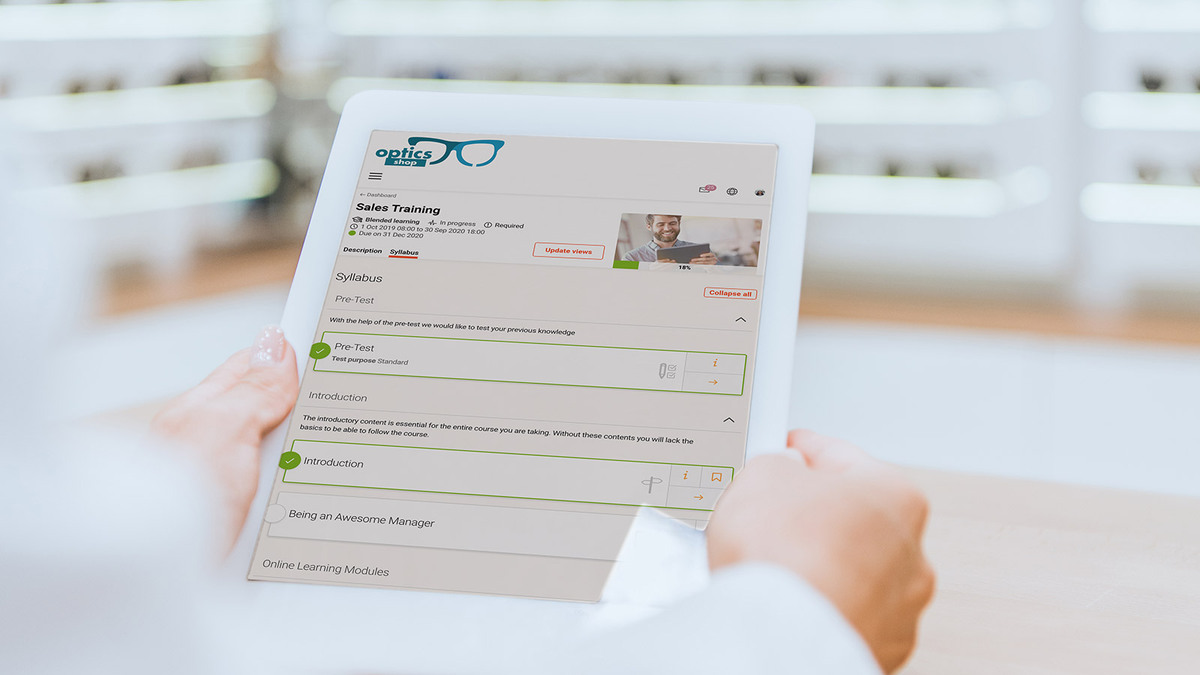
NOTE
Distributors, trading partners AND external sales people all have the same need for specialist and product knowledge. Leaving out this target group when arranging learning and development measures is a missed opportunity for significant revenue growth.
Which target group should an extended enterprise training scenario take into account?
The circle of distribution partners includes more than just external sales employees. Depending on the sector and the orientation towards B2B or B2C business, a completely different set of target groups should be addressed and included. For example:
- Distributors and dealers (car dealerships, opticians)
- Franchisees (restaurants, insurance companies, real estate agents, etc.)
- Specialist staff in the insurance, health or medical technology sectors
- Joint ventures
- Partners
- Customers
- Members and voluntary staff
- Friends and family
- The general public

Sales training for external partners: online or in person?
Once the external partner network has been defined, the question is: Is it better to train these employees online or in person? Both options have advantages and disadvantages which need to be balanced precisely. The idea to present such distributor training online – for instance, in a learning management system (LMS) – is not new.
The benefits are obvious: Instead of sales consultants travelling to attend on-site training, all employees ultimately involved in selling the product can complete relevant product training in the convenience of their home or their workplace using various devices. For instance, an optics manufacturer placing their products with various chains can provide remote access to the product training to all sales staff of those chains’ branches.
However, the drawback of such online training is that employees are often under time pressure or lack motivation to get started with such training. It is therefore crucial to minimise any barriers to entry for training measures.
For instance, complicated registration processes act as a deterrent. Combined online and face-to-face training within a hybrid learning concept or even a true blended learning scenario may also be suitable options.
Having assisted numerous imc customers with the development and support of such training, training expert Anika Rabe recommends:

Anika Rabe
“Most of the time, product training is not designed for the general public and must therefore be set in a secure area. An LMS is a suitable option for this.
Yet, the training courses must be easily accessible for everyone and, above all, they must be interesting. In particular, external employees must be involved on an emotional level rather than stopping at technical product knowledge.”

Facts tell, stories sell
No emotion – no sales. Especially when technical differences between products or brands have no major impact, brand loyalty and great storytelling are key.
An external employee needs at least the same degree of emotional investment as a team member of the manufacturer - they must both convey enthusiasm for the product. That is exactly what product training needs to deliver. Items like smartphones, jewellery or cars are frequently bought for emotional reasons, rather than based on mere facts.
If a sales consultant can share their enthusiasm for a product, customers are more likely to buy it – even if, objectively, it is not better or cheaper.

One size fits all is a thing of the past
The training that helps external partners internalise these stories differs from that most helpful to your own employees. Internal team members already have a special connection to the brand or the products. They already believe in the quality standard, and need not be won over.
This is an important aspect to take into account. One-size-fits-all solutions no longer have a place in training design – and even the best training will fail if it is unnecessarily difficult to access. This is why training expert Anika Rabe recommends: “Making it easier to access learning means making it more likely for the learning experience to be shared by everyone. For example, adding a QR code to products that are new or involve a steep learning curve is easy, and can be used to direct the user to the relevant training course with a simple scan.”
However, Anika notes that simplified access also makes it harder to verify training. If a training course requires no prior authentication, the creator of the learning content cannot know with certainty whether the end user really completed it, nor how much time they invested. It also remains unknown how much the learner actually learned, and whether they actively apply that knowledge.
Yet such assessment is important, especially when optimising and evaluating learning content. While in-depth learning analytics would be taking things too far in this context, it is a topic L&D managers should keep an eye on.
Combining both worlds to boost sales
According to Dr. Wolfram Jost, Board Member and Head of Product Management at imc, the only thing that really matters in the end is this: The learning curve must be transformed into an earning curve. No company trains employees just for fun – whether that is internal employees or external partners. Especially in the extended enterprise learningscenario, the fundamental objective is to increase the company’s sales. Partner training must contribute to corporate success.
It helps to keep these key questions in mind when designing your extended enterprise training to transform the learning outcome into revenue.
- Objective: What is the training designed to achieve?
- Target group: Who is meant to be trained? What prior knowledge does my target group have? What information and which stories do they need?
- Conceptual design: What type or combination of training is suitable?
- Performance assessment: How do I define success? How and when do I measure it?
- Training access: How can I simplify training access?
- Learner motivation: How can my training design ensure that external partners enjoy the training process and retain the learned content?

Onboarding, slightly different
Onboarding can already be integrated into an existing LMS, but this benefit is hardly ever used.
We took a little trip into the (near) future to see what a successful onboarding process could look like.

Why the gains from an LMS outweigh its costs
A Learning Management System too expensive? Not if you use it in the right way! For most clients, an LMS pays for itself within a year. We tell you how to prove that with a Business Case.

More about our LMS
If you would like to learn more about imc's Learning Management System, check here for more information.

Contact person
I have been working in the Marketing & Communication Team at imc since March 2019.
Communication, creative content and social media are my passion. "KISS - Keep it short and simple" is my credo.
To explain complex content in an understandable way and thus make the topic of e-Learning accessible to everyone is an exciting challenge every day.
Privately I love to read, play poker and travel a lot.
I am always happy to receive feedback or suggestions.

Never file folders again!
How a validatable LMS significantly saves on time and paper
An interview with a representative from the medical technology industry
There will always be challenges to face when converting or introducing a Learning Management System (LMS). However, it becomes even more difficult if the learning platform also needs to map validatable processes. This is a particularly important issue in the medical, pharmaceutical and medical technology industries, as work processes and training courses must be fully documented. We spoke with a representative from the medical devices industry who recently made this type of changeover.

Hans-Heiko Müller, Team Manager for Organisational Learning at pfm medical ag
Hans-Heiko Müller works for pfm medical ag, an internationally operating medium-sized family business from Germany that offers special solutions in the healthcare sector. As Team Manager for Organisational Learning, he is responsible for the documentation of internal training and professional development.
He had already been working with imc's LMS and the imc Learning Suite since 2014 and initiated and oversaw the company's conversion to a validatable system. In this interview, he tells us how the conversion went, what challenges he and his team faced, and how many metres of DIN-A4 folders he now saves.
INFO
The term validation or validation obligation means that detailed evidence that a technical process has complied with requirements must be documented. Simply stated, the aim is to assure the quality of a product in order to prevent serious errors. This is extremely important for eliminating the endangerment of patients in high-risk industries such as the pharmaceutical industry and the manufacture of medical devices.

Hello Mr Müller, please tell us: What do validation processes and learning management systems have to do with each other?
The European Medical Device Regulation MDR and the U.S. Food and Drug Administration FDA impose very strict requirements for this. These requirements state that, if a computer-aided system is integrated into a quality-relevant manufacturing process, documented evidence of this must be provided.
This evidence must show that the system meets the requirements and will perform exactly as specified, both now and in the future. In other words, the system, or in our case the LMS, must be verifiable at all times, and every process must be clearly traceable. This applies, for example, to any changes made to training materials.
At pfm medical, you decided to take the step towards a validatable LMS in mid-2020; how did this come about?
There were several reasons. For one thing, we have to meet the legal requirements, and the European Medical Device Regulation, which was enacted in 2017 and is mandatory as of May 2021, included some innovations that had to be implemented.
Another consideration was the fact that, generally speaking, documentation prior to validation was very time-consuming. We had to carry out a great many procedures manually.

How can I picture this manual documentation?
Basically, all employees must complete certain training courses, for example professional development courses on the individual products. Depending on the type of training, it may need to be repeated or renewed on a regular basis.
Before the conversion, the documentation worked like this: We manually enrolled an employee in the course, and they were able to complete it either online in the LMS or in person. Afterwards, they had to print out a certificate showing that they had taken the test, acknowledge this with their signature and either submit the slip in person or send it by post.
After receiving the letter, we had to check whether the employee was really enrolled on this course and confirm their participation manually in the system. Because we are required to keep these records by law, and in some cases for decades, we manually filed the supporting documents in paper folders.
This added up to about ten running metres of DIN A4 folders within two years. My colleague and I spent several hours each week comparing and categorising. This standard procedure, which is the order of the day in many companies in the medical technology sector, ties up a lot of resources.
That sounds very cumbersome indeed. What does this process look like now with a validatable LMS?
All employees are assigned to different groups, and I can book these groups in specific training courses and onto specific learning paths. The additional professional development courses that are relevant for validation are also found there.
Let's take the example of medical device consultants who have to instruct doctors on our products. If I specify that the group with all consultants must attend a training course on the latest products every year, the system automatically books the entire group into the appropriate training courses. I can also set automated reminders (called escalation management) in the system. This will send a reminder to those who have not completed the training course by a certain time.
Once the employees have completed the course, they can log it directly into the system. To do this, they have to be logged in with their user name and password and also confirm their participation with their electronic signature (e-signature). That's it. We can then see when the employee has completed the training course, and the certificate is stored in the system. We don't have to print anything out or file anything extra.

Can you give us some insights into what was important to you when selecting a vendor?
We not only wanted support with the conversion of the system, but also help with the documentation going forward, because with every update, with every small change I make in the LMS, the potential impact of the change has to be documented. This is extremely time-consuming, and each update quickly adds up to 100 pages.
Theoretically, we could also do this work ourselves, in other words, run through all the scenarios completely and document them. However, I would need to hire at least one full-time employee to do this. We wanted a "comprehensive, worry-free package" that would not only cover the issue of security, but also make our work considerably easier.
What was the actual conversion process like?
First, we worked with imc to create a requirements analysis of the company's learning processes. This involves such aspects as the organisational structure and the structure of the learning content or learning processes. This was followed by the reconciliation of validation documents and the provision of user requirements and functional requirements including risk analysis.
Then, in the planning phase, we were provided with a development system (DEV system) for initial workshops. In the workshops, for example, the administrators were trained, and we set the system up and used it on a test basis together. In the third phase, a test system, or STAGE system, was put into production, and this in turn was tested. This was followed by the deployment of the productive system.
The process took just under four months altogether. If we had done it completely on our own, it would have taken us an estimated 18 to 24 months.
Did you have any fears or anxieties about the conversion beforehand? How did you deal with them?
Of course, we had respect for a project of this magnitude. But we saw the conversion as an opportunity to bring the old world into the digital age. For example, we took another look at all the processes and checked to see where they could be streamlined.
As a result, we now have training processes that are uniform for all employees, including those of our subsidiaries. There was a real change in culture which was also initiated by the fact that we worked with so many different departments.
At the same time, this presented a certain challenge, in that we first had to find out which "language" everyone spoke. Terms such as system or DEV system can be interpreted differently by each department. For example, since we worked with HR as well as IT, it was immensely important to make sure that everyone knew what was meant by which term. Clear agreements and a regular exchange are essential for this.
Were there any other challenges?
Personally, I didn't find it easy to relinquish some of the responsibility and rely on an outside vendor, because as I mentioned, I had already been working with the LMS since 2014, knew how it worked, and could make changes myself.
During the conversion, however, it was the provider, and not I who worked on the system. In a way, that was a leap of faith, because I didn't know exactly what was going on in the background. It made me a little nervous at first. However, we agreed on short sprints, in other words, weekly coordination meetings with the possibility of readjustments, so that I was reassured and could follow where we were in the process at any time.
However, you should be aware that you lose some flexibility with this sort of system. Changes that I could previously make myself with a check mark are now locked and have to go through a change process which has to be applied for, checked within the context of a four-eyes-principle and documented before it can be implemented. This strict process ensures the prescribed safety, but the price is less flexibility. Still, the advantages clearly outweigh the disadvantages for pfm medical.

What would you recommend to companies facing the decision to have their system changed?
My advice: You have to take a careful look at the processes in advance and then have the courage to adapt them to the technology. Not the other way around. This way you can be sure that there will be no problems during audits.
Thank you so much for all your insights!
Further information
Curious to find out more about pfm medical's validatable LMS? Then check our reference page.
Or download the whitepaper about how to master validation with an LMS.
Not enough? Then watch the webinar recording with Hans-Heiko Müller related to the topic validation in a LMS (German only).

How not to break bad with validated processes in an LMS
What requirements must an LMS map for validated processes? And how does Breaking Bad fit here? Questions about questions not only the Pharmaceutical industry should think about.

Learning Analytics: It comes down to the right questions
Learning must not be an end in itself, but fit in the company’s business outcome: More and more managers are demanding this. We therefore looked at how L&D managers can meet this requirement with the help of Learning Analytics.

More about our LMS
If you would like to learn more about imc's Learning Management System, check here for more information.

Contact person
I have been working in the Marketing & Communication Team at imc since March 2019.
Communication, creative content and social media are my passion. "KISS - Keep it short and simple" is my credo.
To explain complex content in an understandable way and thus make the topic of e-Learning accessible to everyone is an exciting challenge every day.
Privately I love to read, play poker and travel a lot.
I am always happy to receive feedback or suggestions.

learning culture
When the Act of Learning Becomes a Habit
Organisations that can readily adapt and change are the one's that succeed. Those who look beyond using learning for compliance are reaping the benefits.
A featured article in The Australian Financial Review
Researcher Imed Bouchrika, writing on research portal Guide2Research, says training has become an integral part of workforce development, employee performance and organisational competitiveness, noting that “intellectual capital is valued just as much as physical and financial assets”.
“Training and development is most effective when implemented strategically, which involves content development, method of delivery and integration of technology,” Bouchrika writes.
To remain competitive, continuous learning has become imperative in creating and maintaining a sustainable advantage.

imc's featured article as printed in the Australian Financial Review
Nick Petch, head of learning experience design and strategy at imc Australia, says a “big shift” is needed in organisations’ approach to learning and development.
“For many organisations, the core skills and competencies that drive their organisations have shifted and changed almost overnight. Overcoming these challenges means radically changing the way learning and development occurs,” he says.

Reaching Business Growth by Learning & Development
Bringing all parts of digital learning together will increase revenue, improve efficiencies and organisational growth.

Redefining Your Organisation’s Learning and Development Strategy
The digital transformation of learning is having an immediate and notable impact on business performance. The dominant behaviours that will define success are adaptability, nimbleness and alignment.
Contact



